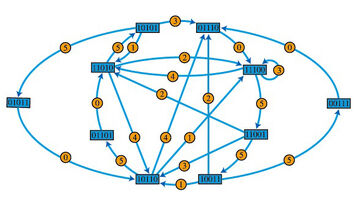
State graph (3,5): A map of all the possible states for asynch non-multiplex 3 object siteswaps with a maximum throw value of 5.
A state is a "landing schedule" for the objects in a siteswap pattern. Rather than describing the whole pattern, state notation only describes what the pattern is like at a certain point in time. It designates the times in the future when each object will be thrown next.
Writing a state
A state is sometimes written as a sequence of 1s and 0s, and sometimes as a sequence of Xs and dashes, with the left side (or sometimes the right side) representing the objects that will be thrown again soonest. This article will use 1s and 0s, with the objects to be thrown next on the left.
Every possible sequence of 1s and 0s represents a siteswap state. The number on the left end of the sequence is the next beat that will occur in the future (the next prop to be thrown), and a prop in this position is considered the earliest prop in the current "landing schedule" (although it and the next prop may have actually already landed in the hands).
The state at any point in a 3 ball cascade is 111. The 1s represent the props, so the number of 1s in a state is always the number of props used in the pattern. 111 means that a ball is scheduled to be thrown on each of the next three beats.
A 0 is a gap in the schedule, meaning there is currently no ball that will be thrown again next at the time the position of the 0 indicates. The state 111 could also be written as 1110, 11100, 111000, etc. because at a given time during this pattern all of the balls are scheduled to be thrown again in the next 3 beats, so all the beats after that are empty according to the current landing schedule.
Changing the state
When a throw (any siteswap number including 0, 1, and 2) is made, the state can change - the 1 on the left end of the sequence (if there is a 1 there) is moved a certain number of places to the right. The number of places the 1 moves to the right is the siteswap value of the throw. The 1 can only be moved to a place where it replaces a 0 (though the 0 may not be written if it's to the right of the last 1), so there are certain throws that cannot be made from a given state.
A state with no 0s in it (other than the optional 0s that can be written after the last 1) is called the ground state. This is the state that is maintained while juggling the basic pattern. If a 3 ball cascade throw is made from the ground state, 111, the 1 on the left is moved three places to the right, which puts it just to the right of the other 1s, and leaves the state looking the same as it did before that throw was made: 111. The ground state is the only state from which a single throw (just one number in the siteswap) can be made without changing the state.
Since a 1 can only be moved to a spot where it replaces a 0, only throws with a siteswap value of 3 or higher can be made from the state 111. Throwing a 4 from the 3 ball cascade moves the 1 on the left four places to the right, leaving a 0 between it and the other 1s: 1101. Now the 1 on the right is in the way of throwing a 3, but the spot two places to the right of the leftmost 1 is empty, so the next throw can be either a 2 or anything higher than a 3. Throwing another 4 gives the state 1011, which allows either a 1 or something higher than a 3 (but not a 2 or a 3) for the next throw. Following this with a 1 brings the pattern back to the ground state, 111.
Throwing a 5 from the basic pattern would result in the state 11001, which could be followed by a 2, a 3, or something higher than a 4, but not a 4. Throwing three 4s in a row from the ground state creates the state 0111. A 0 is the only option for the next throw from this state because there is no 1 on the left end to throw. A 0 can only be done (and is the only thing that can be done) if there is a 0 on the left end of the sequence of 1s and 0s. Doing a 0 from 0111 removes the 0 from the left end of the sequence and brings the state back to 111.
State table
This is a state table for 3 balls, maximum throw height 5. It shows which throws are possible from each state, and which state results from each throw.
|
00111 |
5 |
X | ||||||||
|
01011 |
5 |
X |
||||||||
|
10011 |
5 |
X |
||||||||
|
01101 |
5 |
X |
||||||||
|
10101 |
5 |
X |
||||||||
|
11001 |
5 |
X |
||||||||
|
0111 |
4 |
X |
3 |
2 |
0 | |||||
|
1011 |
4 |
X |
3 |
1 |
0 |
|||||
|
1101 |
4 |
X |
2 |
1 |
0 |
|||||
|
111 |
3 |
2 |
1 |
0 |
||||||
|
111 |
1101 |
1011 |
0111 |
11001 |
10101 |
01101 |
10011 |
01011 |
00111 |
The ground state is row/column 111. All the throws that are possible from this state are in the 111 column. The 5 in this column is in row 11001, so throwing a 5 would change the state from 111 to 11001. The X in the same row as this 5 marks where the column for state 11001 is. All the numbers in that column are possible throws from state 11001, so the 5 can be followed by another 5, a 3, or a 2. Doing a 5 changes the state to 10011, and the column for that state (marked by another X) contains the three possible next throws: 5, 2, or 1. Throwing one more 5 brings the state to 00111, and the only possibilty in the column for that state is 0. Throwing a 0 changes the state to 0111, and the column for that state also has only the option 0. Doing one more 0 brings the pattern back to the ground state, completing a one round of a ground state pattern: 55500.
A ground state siteswap is a siteswap that is in the ground state (a state that can be written using only 1s) at some point during the pattern, e.g. 531, 552, 645. An excited state siteswap is a pattern that is never in the ground state, e.g. 51, 561, 771. Ground state siteswaps can be entered directly from the basic pattern, but going from the basic pattern to an excited state siteswap requires special transition throws.
The 3 ball shower, 51, alternates between states 1101 and 10101, and never has state 111, so it's an excited state siteswap. One way to switch from 3 to 51 and back is to throw a 4, which changes the state from 111 to 1101, and then after doing 51 do a 2, which changes the state from 1101 back to 111. The ground-state-to-excited-state transition throws and the excited-state-to-ground-state transition throws always form a valid ground state pattern, in this case 42.
A pattern that has a different state on each beat is called a prime siteswap. 441 is a period 3 siteswap with three different states (111, 1101, and 1011), so it's a prime siteswap. A pattern that has the same state on more than one beat is called a composite siteswap. 423 is a period 3 siteswap with only two different states (111 before the 4 and before the 3, and 1101 between the 4 and the 2), so it's a composite siteswap. A composite siteswap is a combination of two or more prime siteswaps, in this case 42 and 3.
